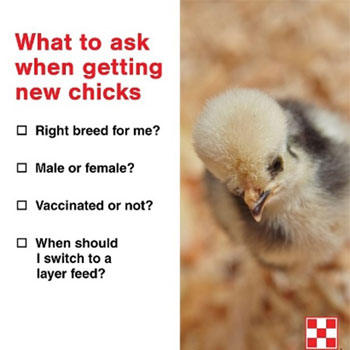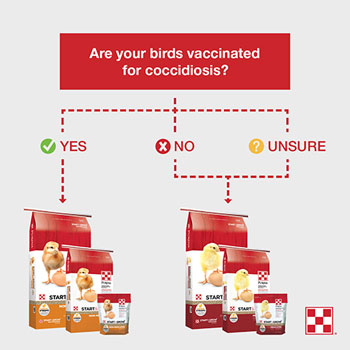
Questions to Ask When Picking up New Chicks
Starting a Flock : Caring for Chicks

You’ve researched your city rules and set-up your brooder. Now it’s time for the fun part: picking up new chicks! Learn what questions to ask before picking up the newest additions to your backyard flock.
New chick parents, you’ve come to the right place. Backyard chickens are an amazing addition to your family. They bring you companionship, delicious farm fresh eggs and a true connection to the food your family eats. When you’re ready to visit a feed store or order chicks from a breeder or hatchery, it’s important to ask the right questions when picking out your chicks.
 On the other hand, cold-tolerant breeds are typically larger in body size with heavier feathering for natural warmth. If you live in an area with frigid winters, consider breeds such as Araucana, Australorp, Barred Rock, Minorca, Orpington or Wyandotte breeds.
On the other hand, cold-tolerant breeds are typically larger in body size with heavier feathering for natural warmth. If you live in an area with frigid winters, consider breeds such as Araucana, Australorp, Barred Rock, Minorca, Orpington or Wyandotte breeds.
For the most part, suppliers are going to keep birds that are easy for you and your family to care for, like Buff Orpingtons, Barred Rocks and Ameraucanas. When you get more experienced, start looking into breeds that are a little more exotic or possibly require more management.
A trained professional can use vent- or feather-sexing depending on breed. Unless the breed shows gender phenotypically, it takes lengthy training to sex a chick correctly. For this reason, be sure to tell your supplier if you’d like pullets (females) or cockerels (males).
Still, the truest way to determine gender is to watch the chick grow. In the teenage phase, males will become larger with more pronounced combs and wattles and longer tail feathers. While it takes more time, observation is the most practical and accurate way to determine the sex of a chick.
Crowing can also help determine gender. Most roosters begin to crow as they approach sexual maturity which can range from 3-5 months after hatching, depending on the breed.
This information is especially useful for those living in areas with restrictions. In either case, have a plan in place in case you accidentally pick up a rooster.
 Next, confirm if chicks were vaccinated. Many hatcheries vaccinate chicks before shipment.
Next, confirm if chicks were vaccinated. Many hatcheries vaccinate chicks before shipment.
To prevent potential disease problems, make sure chicks are from a credible U.S. Pullorum-Typhoid Clean hatchery or trusted breeder. Ensure the hatchery vaccinated your chicks for both coccidiosis and Marek’s Disease, a Herpes virus found in poultry.
If chicks have been vaccinated against coccidiosis, a non-medicated complete feed should be provided. Select a complete feed that includes enhanced amino acids to promote early chick development, prebiotics and probiotics to support immune health and a balance of vitamins and minerals to support bone health and bird growth.
If chicks were not vaccinated or you’re not sure, protect them with a medicated feed. Medicated complete feeds, like the medicated option of Purina® Start & Grow® Premium Poultry Feed, includes amprolium. Amprolium is a coccidiostat formulated to help the young chick to develop an immunity to coccidiosis (an internal parasite) as they grow into adulthood.
Because a bird’s best friend is consistency, we recommend having a plan in place for layer season from day one. When picking up new chicks, ask for recommendations on both starter and layer feeds. Choose a layer feed with the Purina® Oyster Strong® System to help your hens lay strong and stay strong. For consistency, offer the same feed brand from start to lay.
Which layer feed Oyster Strong® System is right for your flock?
Ready to bring new chicks home? Visit our new chick parent page with helpful guides, articles and videos to help your newest flock members thrive.
New chick parents, you’ve come to the right place. Backyard chickens are an amazing addition to your family. They bring you companionship, delicious farm fresh eggs and a true connection to the food your family eats. When you’re ready to visit a feed store or order chicks from a breeder or hatchery, it’s important to ask the right questions when picking out your chicks.
1. Is this the right chicken breed for me?
Chicken raising is the most fun when you have a breed best suited for your goals and climate.- Goals: For fresh eggs, consider: White Leghorn hybrids (white eggs), Plymouth Barred Rocks (brown eggs), Rhode Island Reds (brown eggs), Blue Andalusians (white eggs) or Ameraucanas/Easter Eggers (blue eggs). Cornish Cross chickens grow quickly and are best suited for meat production. If you’re hoping to produce both eggs and meat, consider dual-purpose breeds like Barred Rock, Sussex or Buff Orpingtons.
- Climate: Select a breed that will do well in your environment. Heat-tolerant breeds are typically smaller with lighter feathering and bigger combs and wattles to help with heat dissipation. Heat-tolerant breeds for beginners include Leghorn, Minorca, Rhode Island Red, Turken and Ameraucana.
 On the other hand, cold-tolerant breeds are typically larger in body size with heavier feathering for natural warmth. If you live in an area with frigid winters, consider breeds such as Araucana, Australorp, Barred Rock, Minorca, Orpington or Wyandotte breeds.
On the other hand, cold-tolerant breeds are typically larger in body size with heavier feathering for natural warmth. If you live in an area with frigid winters, consider breeds such as Araucana, Australorp, Barred Rock, Minorca, Orpington or Wyandotte breeds. For the most part, suppliers are going to keep birds that are easy for you and your family to care for, like Buff Orpingtons, Barred Rocks and Ameraucanas. When you get more experienced, start looking into breeds that are a little more exotic or possibly require more management.
2. Are the chicks males or females?
It is often difficult to tell the gender of baby chicks. Because it takes a trained eye for sex determination, ask the supplier for the gender and then use that information to pick your new chicks.A trained professional can use vent- or feather-sexing depending on breed. Unless the breed shows gender phenotypically, it takes lengthy training to sex a chick correctly. For this reason, be sure to tell your supplier if you’d like pullets (females) or cockerels (males).
Still, the truest way to determine gender is to watch the chick grow. In the teenage phase, males will become larger with more pronounced combs and wattles and longer tail feathers. While it takes more time, observation is the most practical and accurate way to determine the sex of a chick.
Crowing can also help determine gender. Most roosters begin to crow as they approach sexual maturity which can range from 3-5 months after hatching, depending on the breed.
This information is especially useful for those living in areas with restrictions. In either case, have a plan in place in case you accidentally pick up a rooster.
3. Are the chicks vaccinated?
 Next, confirm if chicks were vaccinated. Many hatcheries vaccinate chicks before shipment.
Next, confirm if chicks were vaccinated. Many hatcheries vaccinate chicks before shipment.To prevent potential disease problems, make sure chicks are from a credible U.S. Pullorum-Typhoid Clean hatchery or trusted breeder. Ensure the hatchery vaccinated your chicks for both coccidiosis and Marek’s Disease, a Herpes virus found in poultry.
If chicks have been vaccinated against coccidiosis, a non-medicated complete feed should be provided. Select a complete feed that includes enhanced amino acids to promote early chick development, prebiotics and probiotics to support immune health and a balance of vitamins and minerals to support bone health and bird growth.
If chicks were not vaccinated or you’re not sure, protect them with a medicated feed. Medicated complete feeds, like the medicated option of Purina® Start & Grow® Premium Poultry Feed, includes amprolium. Amprolium is a coccidiostat formulated to help the young chick to develop an immunity to coccidiosis (an internal parasite) as they grow into adulthood.
4. When will these chicks start laying eggs?
The age when hens start laying eggs varies by breed, often around 18 – 20 weeks of age. Ask the supplier when your selected breed will begin laying. Then, create a plan for transitioning to a complete layer feed before the first egg arrives.Because a bird’s best friend is consistency, we recommend having a plan in place for layer season from day one. When picking up new chicks, ask for recommendations on both starter and layer feeds. Choose a layer feed with the Purina® Oyster Strong® System to help your hens lay strong and stay strong. For consistency, offer the same feed brand from start to lay.
Which layer feed Oyster Strong® System is right for your flock?
- Purina® Farm to Flock™ 18% Layer Supports gut health
- Purina® Layena® pellets or crumbles Our most popular layer feeds
- Purina® Layena® Omega-3 Includes added omega-3 fatty acids for your health
- Purina® Layena® High Protein Includes insect protein
- Purina® Organic Layer Feed Certified USDA Organic
Ready to bring new chicks home? Visit our new chick parent page with helpful guides, articles and videos to help your newest flock members thrive.



